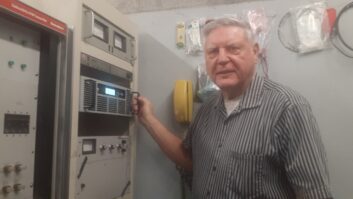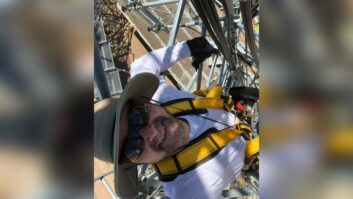WASHINGTON Translators aren’t just for filling in FM signal coverage gaps anymore.
They have become a more important part of radio owners’ spectrum strategy toolkit. Many commercial and noncommercial radio operators — both AM and FM — are using FM translators in ways previously unimagined, not only supplementing local signal coverage but leveraging them to gain a more lucrative footprint on the FM dial for content that originally airs on AM stations or FM HD2/HD3 channels.
Demand for translators also is increasing as broadcasters realize they effectively can create additional radio stations in markets by location-hopping and moving towards more heavily populated areas, according to several technical radio observers.
An FM translator retransmits the signal of an AM or FM radio station without significantly altering characteristics of the original other than its frequency and amplitude. FM translators historically have been used to fill in coverage where terrain blockage was an issue.

A discussion of translators for AM use, from a presentation by Doug Vernier. Images courtesy SBE
There were 6,141 licensed FM translators and boosters as of March 2011, according to the FCC. That compares to 3,897 in 2005 and 3,243 in 2000, according to commission data. FM boosters essentially are translators that operate on the same frequency as the primary station. The FCC doesn’t distinguish between FM translators and boosters in its database.
Approximately 500 FM translators simulcast AM broadcast stations. That’s a measure of the success of a rule change, adopted just two summers ago, allowing AMs to use existing FM translators in certain circumstances.
Observers say radio’s evolving translator strategies simply take advantage of current translator rules. For instance, a broadcaster can add a fill-in translator with power up to 250 watts regardless of antenna height as long as it does not exceed the protected contour of the associated primary station.
Interestingly, the 60 dBu of a 250 watt fill-in translator at 2,000 feet height above average terrain presents the same coverage area as a Class B or C2 FM station, thus “creating fairly high-power entities,” said Doug Vernier, president of broadcast engineering consulting firm V-Soft Communications.
This creative use of translators is a fairly recent phenomenon, Vernier said, as broadcasters have learned to recognize the opportunities.
“A fill-in at 250 watts in a small town could cover 10 miles. People have also figured out how they can move translators into AM coverage areas and the FCC seems more comfortable with that. The rules really haven’t changed, but the benefits have,” Vernier said. He hosted a Society of Broadcast Engineers webinar in May on creative strategies for translator use.
Multicast channels
In addition, the advent of HD Radio has stimulated interest in using FM translators, said Vernier.
“A broadcaster with an HD2 or HD3 can take a signal to feed a translator as a fill-in, and all of the sudden you have another FM station in the market. So you have your primary FM and another FM with the HD2 programming.”
FM translators typically are not subject to the multiple ownership rules, Vernier added, but the commission has warned that it is an abuse of agency rules to use two or more cross-service translators to effectively create a de facto FM station to circumvent local ownership limits.
Broadcasters certainly have been anxious to gain access to additional FM outlets where they can, observers said.
Backyard Broadcasting, which operates 29 stations in six radio markets, is in the process of acquiring a broadcast license from Educational Media Foundation for translator W275AJ in Muncie, Ind., which eventually will simulcast programming from the group’s WXFN(AM). The sports talk station is a 1,000 watt full-time AM at 1340 kHz.
“We think it is all about making programming more accessible to the listener. Whether it’s a mobile phone app or adding another frequency, it’s about finding ways to get our stations in the hands of our listeners. It’s about convenience,” said Backyard Broadcasting President/CEO Barry Drake.
National Public Radio has promoted the use of FM translators throughout the public radio system since at least 2002, said Vermont Public Radio Director of Engineering Rich Parker. The statewide network of public stations uses a series of 14 translators to enhance coverage area.
“The expansion of our VPR classical network allowed us to switch to two full-time networks — news and classical — in 2007. We have since worked to optimize our translator strategy to reduce redundancy,” Parker said.
Vermont Public Radio, which applied for 20 translators during a 2003 filing window, budgets approximately $25,000 per translator expansion, Parker said.
“Ultimately, five of the translator licenses we applied for were either allowed to expire or in some cases sold to local broadcasters at our cost,” he said.
Hop like a bunny
Some evolving strategies prompt the question of whether translators were intended to be used this way.
The FCC is unaware of any formal complaints filed against the practice of using an FM translator to rebroadcast the HD2 or HD3 channel of a primary station, according to an agency official, outside of “normal interference complaints.”
However, illegal translator hopping has gained attention of the commission, as in the case of a Florida licensee who earlier this year attempted to move translators from the Florida Keys into the Miami area.
Communications attorney David Oxenford of Davis Wright Tremaine explained in the Broadcast Law blog that sometimes it takes multiple hops to move a translator to a more desirable location. In order to accomplish a move using a minor modification application, at each hop the translator licensee must build a station, license it and then file to move it to the next location before reaching its ultimate destination.
“In this recent case,” writes Oxenford, “a broadcaster entered into a consent decree with the FCC, forfeiting several existing translator licenses to the FCC, dismissing a number of pending applications and agreeing to sell a remaining translator within one year. The licensee was also forbidden from doing business in Florida, and agreed to abide by FCC rules in the future.”
Observers believe it wasn’t the practice of moving translators but how it was done that apparently led to the penalty.
“Two other broadcast companies complained to the FCC about the moves, and the agency concluded that the translator licensee had allegedly ‘constructed’ some of his intermediate hops not on broadcast towers, but at roadside pull-offs. At most, according to the FCC, many of these ‘constructed’ sites involved nothing more than driving a truck with an antenna on it to the location of the transmitter site specified in a construction permit, pulling off the road, operating for a few hours, then packing it all up and driving away,” Oxenford wrote.
The attorney continued: “Yet the translator operator filed a license application claiming to have constructed the station (never mentioning that the station soon went off the air when the truck drove away).
“Compounding the problems were that at least one of the construction sites was off the air for over 30 days without notifying the FCC, and there were questions of site assurance as many of the transmitter site locations were in public parks and parking lots, where it was very unlikely that there could have been permission to use the site for a broadcast transmitter, even had the truck stayed put.” Translator hopping
However, this case seems to be an exception.
Translator location hopping has become a popular legal option for broadcasters hoping to edge a signal contour to a major population area, Vernier said.
“A licensee can move a translator as long as some of the old 60 dBu crosses over into the new contour. There are no principal community service rules when it comes to translators, unlike FM full-service stations,” he said.
Broadcasters in general also are finding it easier to change translator frequencies to avoid interference issues, Vernier said.
“FCC rules say that a change of channel greater than the third-adjacent would be considered a major change,” he said. “However, the FCC has become kinder and gentler on channel moves greater than three channels.”
The commission also no longer allows a commercial-band FM translator to move into the noncommercial band unless the translator has been licensed for two years or more. The same applies to noncommercial stations hopping into the commercial band, said Vernier.
The agency approved cross-service translation in 2009 as a means to mitigate AM coverage problems. An AM day-time station can originate programming on its FM translator at night, according to the commission.
In Summary A summary of key translator points from Doug Vernier’s presentation:
– Fill-in FM translators offer significant opportunities for both FMs and AMs.
– There is a freeze on new translators.
– Translator upgrades and site moves are popular.
– Translators can be displaced.
– Outgoing and incoming interference is an important issue.
– A translator can run another station’s HD2 or HD3 as input.
According to the FCC’s rules, no portion of the FM translator’s 60 dBu may exceed the 2 mV/m AM signal contour or 25 mile radius from the AM transmitter. AMs that want to re-transmit their signal on an FM translator are limited to those translators with existing licenses and permits as of May 2009.
The relatively low cost of setting up a translator also is attractive to broadcasters. Most all translators have a similar implementation: a small transmitter, a signal receiver or input device and an antenna. An FM translator can be set up for as little as $5,000, observers said. However, monthly tower rental expenses could add additional costs.
Noncommercial and commercial broadcasters have been active in the translator market, said Larry Patrick, managing partner of Patrick Communications, a radio brokerage firm.
“Interest in translators is very strong. As a broker there is a big demand. We routinely ask engineers to find translators that can be moved into markets for clients who want them,” Patrick said.
“Saga was active in this several years ago and now dozens of other groups are adding stations this way. Cumulus among them has been quite active in the translator market.”
Cumulus has made several recent move, putting translators on the air in Atlanta and Kansas City. In Atlanta, the broadcaster is rebroadcasting the HD2 channel for WWWQ(FM) on a translator at 97.9 MHz. Meanwhile, in Kansas City it has launched a comedy service on the HD2 channel of KMCO(FM) and is rebroadcasting it on a translator at 102.5 MHz, according to the company’s website.
Cumulus officials didn’t return calls seeking comment on their translator strategy.
A number of translators are on the market thanks to the FCC’s 2003 filing window for new FM translator stations in the non-reserved band, experts said. Auction 83 included commercial and noncommercial broadcasters who combined to file some 13,000 applications.
Controversy arose when thousands of allegedly speculative applications were filed by several organizations.
The FCC processed thousands of translator construction permits resulting in a range of translator licenses available on the market, observers said. However, the FCC invoked a freeze on issuing any new FM translator licenses on March 17, 2005, to “figure how best to harmonize our licensing processes for FM translators and LPFM stations to enhance localism,” according to a Second Order on Reconsideration and Further Notice of Proposed Rule Making (FCC 05-75).
The commission was expected to issue an NPRM last month on the issue of prioritizing licensing LPFMs and FM translators.
Comment on this or any story. Write to [email protected] with “Letter to the Editor” in the subject field.







